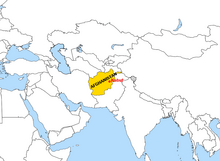
Back Geskiedenis van Afghanistan Afrikaans Rikisi no Afohan AMI تاريخ أفغانستان Arabic Historia d'Afganistán AST Əfqanıstan tarixi Azerbaijani Афғанстан тарихы Bashkir Гісторыя Афганістана Byelorussian История на Афганистан Bulgarian আফগানিস্তানের ইতিহাস Bengali/Bangla Història de l'Afganistan Catalan
| History of Afghanistan |
|---|
 |
| Timeline |

The history of Afghanistan, preceding the establishment of the Emirate of Afghanistan in 1823 is shared with that of neighbouring Iran, central Asia and Indian subcontinent. The Sadozai monarchy ruled the Afghan Durrani Empire, considered the founding state of modern Afghanistan.[1]
Human habitation in Afghanistan dates back to the Middle Paleolithic era, and the country's strategic location along the historic Silk Road has led it to being described, picturesquely, as the ‘roundabout of the ancient world’.[2] The land has historically been home to various peoples and has witnessed numerous military campaigns, including those by the Persians, Alexander the Great, the Maurya Empire, Arab Muslims, the Mongols, the British, the Soviet Union, and most recently by a US-led coalition.[3] The various conquests and periods in both the Indian and Iranian cultural spheres[4][5] made the area a center for, Buddhism, Hinduism, Zoroastrianism and later Islam throughout history.[6]
The Durrani Empire is considered to be the foundational polity of the modern nation-state of Afghanistan, with Ahmad Shah Durrani being credited as its Father of the Nation.[7] However, Dost Mohammad Khan is sometimes considered to be the founder of the first modern Afghan state.[8] Following the Durrani Empire's decline and the death of Ahmad Shah Durrani and Timur Shah, it was divided into multiple smaller independent kingdoms, including but not limited to Herat, Kandahar and Kabul. Afghanistan would be reunited in the 19th century after seven decades of civil war from 1793 to 1863, with wars of unification led by Dost Mohammad Khan from 1823 to 1863, where he conquered the independent principalities of Afghanistan under the Emirate of Kabul. Dost Mohammad died in 1863, days after his last campaign to unite Afghanistan, and Afghanistan was consequently thrown back into civil war with fighting amongst his successors. During this time, Afghanistan became a buffer state in the Great Game between the British Raj in South Asia and the Russian Empire. The British Raj attempted to subjugate Afghanistan but was repelled in the First Anglo-Afghan War. However, the Second Anglo-Afghan War saw a British victory and the successful establishment of British political influence over Afghanistan. Following the Third Anglo-Afghan War in 1919, Afghanistan became free of foreign political hegemony, and emerged as the independent Kingdom of Afghanistan in June 1926 under Amanullah Khan. This monarchy lasted almost half a century, until Zahir Shah was overthrown in 1973, following which the Republic of Afghanistan was established.
Since the late 1970s, Afghanistan's history has been dominated by extensive warfare, including coups, invasions, insurgencies, and civil wars. The conflict began in 1978 when a communist revolution established a socialist state, and subsequent infighting prompted the Soviet Union to invade Afghanistan in 1979. Mujahideen fought against the Soviets in the Soviet–Afghan War and continued fighting amongst themselves following the Soviets' withdrawal in 1989. The Islamic fundamentalist Taliban controlled most of the country by 1996, but their Islamic Emirate of Afghanistan received little international recognition before its overthrow in the 2001 US invasion of Afghanistan. The Taliban returned to power in 2021 after capturing Kabul and overthrowing the government of the Islamic Republic of Afghanistan, thus bringing an end to the 2001–2021 war.[9] Although initially claiming it would form an inclusive government for the country, in September 2021 the Taliban re-established the Islamic Emirate of Afghanistan with an interim government made up entirely of Taliban members.[10] The Taliban government remains internationally unrecognized.[11]
- ^ Rahimi, Mukiib Rahman. State Formation in Afghanistan: A Theoretical and Political History. Bloomsbury Publishing, 2017.[ISBN missing][page needed]
- ^ Hyman, Anthony (1984). "The Land and the People in History". Afghanistan Under Soviet Domination, 1964–83. pp. 3–22. doi:10.1007/978-1-349-17443-0_1. ISBN 978-0-333-36353-9.
- ^ Griffin, Luke (14 January 2002). "The Pre-Islamic Period". Afghanistan Country Study. Illinois Institute of Technology. Archived from the original on 3 November 2001. Retrieved 14 October 2010.
- ^ Denise Cush, Catherine Robinson, Michael York (2012). Encyclopedia of Hinduism. Routledge. p. 200. ISBN 9781135189792.
{{cite book}}: CS1 maint: multiple names: authors list (link) - ^ "The remarkable rugs of war, Drill Hall Gallery". The Australian. 30 July 2021. Archived from the original on 22 November 2021. Retrieved 22 November 2021.
- ^ "Professing Faith: Religious traditions in Afghanistan are diverse". 16 September 2021.
- ^ "Afghanistan: the land that forgot time". The Guardian. 26 October 2001.
- ^ "DŌST MOḤAMMAD KHAN". Encyclopaedia Iranica. 1995. Retrieved February 8, 2023.
- ^ Watkins, Andrew H. (November 2021). Cruickshank, Paul; Hummel, Kristina (eds.). "An Assessment of Taliban Rule at Three Months" (PDF). CTC Sentinel. 14 (9). West Point, New York: Combating Terrorism Center: 1–14. Archived (PDF) from the original on 29 November 2021. Retrieved 29 November 2021.
- ^ "Who Will Run the Taliban Government?". www.crisisgroup.org. 2021-09-09. Retrieved 2022-10-18.
- ^ "The Taliban: Unrecognized and unrepentant". Middle East Institute. Retrieved 2022-10-18.
© MMXXIII Rich X Search. We shall prevail. All rights reserved. Rich X Search